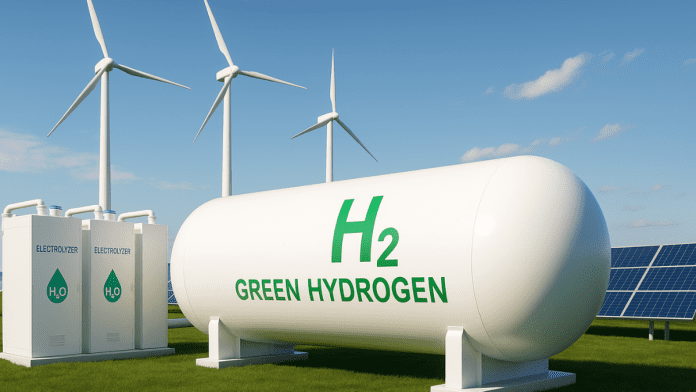🕒 Last updated on July 21, 2025
India is making a powerful move in the clean energy world. In January 2023, the country launched the National Green Hydrogen Mission. This mission aims to boost the production of green hydrogen, a fuel made using renewable energy like wind and solar power.
A Giant Leap in India’s Green Hydrogen Mission
India’s current green hydrogen production is less than one million metric tonnes per annum (MTPA). But by 2030, the target is a big one—5 MTPA.
This is not just a clean energy plan. It’s also a massive ₹10 lakh crore opportunity for industries, investors, and the entire energy market. It could also help India cut down on ₹1 lakh crore worth of fossil fuel imports. That’s a big saving, and it helps India become more energy independent.
One of the key parts of this plan is expanding electrolyzer capacity. Using electricity, electrolyzers assist in separating water into hydrogen and oxygen. India’s current capacity is under 1 gigawatt (GW), but the goal is to reach 20 GW by 2030. This jump will allow more green hydrogen to be made at lower costs.
To help make this happen, many Indian states are stepping up. Maharashtra, Gujarat, Rajasthan, Karnataka, and Uttar Pradesh have all announced friendly policies. These include electricity duty exemptions and giving green hydrogen projects the status of ‘white ’category’—meaning they get faster clearances and are treated as non-polluting industries.
Strong Policies and Big Money Behind the Push
The Indian government isn’t just making promises—it’s putting real money on the table. Through the SIGHT (Strategic Interventions for Green Hydrogen Transition) program, two major components are in action:
- Component I support electrolyzer manufacturing with ₹4,440 crore.
- Component II supports green hydrogen production with ₹13,050 crore.
The plan extends until the financial year 2030. These incentives are being issued by SECI (Solar Energy Corporation of India) through tenders to eligible companies.
On top of that, the National Hydrogen Policy adds more benefits. Projects that are completed before December 31, 2030, get waivers on transmission charges (ISTS) for 25 years. That means they won’t have to pay extra to use power lines across states.
Other benefits include:
- Fast-track open access to renewable energy within 15 days
- 30-day banking to store surplus power
- Exemption from cross-subsidy charges, making it cheaper for private developers
This is all designed to make green hydrogen projects easier and more profitable to run.
Another part of the hydrogen story is green ammonia. Green ammonia is made from green hydrogen and is used mainly in fertilizers. It’s safer to handle, easier to store, and 60–70% cheaper to transport compared to green hydrogen. As of FY24, India uses 22 million metric tonnes (MMT) of ammonia every year.
Globally, ammonia demand is growing fast. From 183 MMT in 2021, it is expected to reach 680 MMT by 2050. Right now, green ammonia costs about $810 per tonne, while the traditional grey ammonia costs around $700. But as renewable energy prices go down and scale increases, the cost difference is shrinking.
Developers, Ports, and Partnerships Driving the Industry Forward
The Production Linked Incentive (PLI) program is another way the government provides assistance. This includes:
- ₹5,258 crore for technology-neutral green hydrogen production
- ₹3,404 crore for electrolyzer production using any type of stack
This has already led to major activity. SECI has granted more than 858,500 MTPA of capacity for the production of green hydrogen. Additionally, about 2,300 MWPA of electrolyzer capacity has been handed out to developers.
⚓ India’s stealth warship sparks alert in Nordic waters—INS Tamal surfaces in Finnish sea lane
Indian companies are getting on board quickly. Companies like NTPC, Avaada, Hero Future Energies, and Greenzo are entering the green hydrogen space. They’re working on everything from making hydrogen and ammonia to building partnerships with foreign firms for exports.
Ports are also being upgraded to support exports. Bunkering and storage facilities are being planned in states like Gujarat, Tamil Nadu, Andhra Pradesh, and Odisha. These ports will help store and load green hydrogen and ammonia onto ships, making India a future global hub.
Many new partnerships are forming to cover every part of the value chain—from fuel for buses and trains to steel production and shipping. Mobility, industry, and export are the key focus areas.
Even though there are challenges—such as high costs, a lack of strong infrastructure, and the unreliable nature of renewable power—the green hydrogen industry is picking up pace. India is making great strides in green hydrogen due to improved technology, more industry interest, and strong government support.

